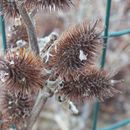en
names in breadcrumbs


Xanthium strumarium (rough cocklebur,[2] clotbur, common cocklebur, large cocklebur, woolgarie bur) is a species of annual plants of the family Asteraceae.[3] Some sources claim it originates in southern Europe and Asia, but has been extensively naturalized elsewhere.[4][5][6] Others, such as the Flora of China and Flora of North America, state it originates in the Americas but was an early introduction to Eurasia.[7][8]
The species is monoecious, with the flowers borne in separate unisexual heads: staminate (male) heads situated above the pistillate (female) heads in the inflorescence.[9] The pistillate heads consist of two pistillate flowers surrounded by a spiny involucre. Upon fruiting, these two flowers ripen into two brown to black achenes and they are completely enveloped by the involucre, which becomes a bur. The bur, being buoyant, easily disperses in the water for plants growing along waterways. However, the bur, with its hooked projections, is obviously adapted to dispersal via mammals by becoming entangled in their hair. Once dispersed and deposited on the ground, typically one of the seeds germinates and the plants grows out of the bur.
The plant may have some medicinal properties[10] and has been used in traditional medicine in South Asia and traditional Chinese medicine. In Telugu, this plant is called Marula Matangi.
However, while small quantities of parts of the mature plants may be consumed, the seeds and seedlings should not be eaten in large quantities because they contain significant concentrations of the extremely toxic chemical carboxyatractyloside. The mature plant also contains at least four other toxins.[11]
Xanthium strumarium – MHNT
Xanthium strumarium (rough cocklebur, clotbur, common cocklebur, large cocklebur, woolgarie bur) is a species of annual plants of the family Asteraceae. Some sources claim it originates in southern Europe and Asia, but has been extensively naturalized elsewhere. Others, such as the Flora of China and Flora of North America, state it originates in the Americas but was an early introduction to Eurasia.